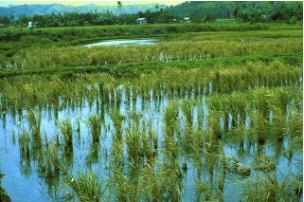Salinity affects the respiration and photosynthesis of rice. It decreases biological N2 fixation and soil nitrogen mineralization. Its other effects on rice growth include;
- reduced germination rate
- reduced plant height and tillering
- poor root growth
- increased spikelet sterility
The major cause of salinity or sodicity include;
- poor irrigation practice or insufficient irrigation water in seasons/years with low rainfall
- high evaporation; Salinity is often associated with alkaline soils in inland areas where evaporation is greater than precipitation.
- increased level of saline groundwater
- salt water intrusion in coastal areas (e.g., Mekong Delta)
How to identify (symptoms)
- tips of affected leaves turn white
- pale, yellow or yellow-white patches as a result of chlorosis appear on some leaves
- plants stunting and reduced tillering
- patchy field growth

How to manage
- Grow salt-tolerant varieties by contacting your local agricultural office
- In rice-upland crop system, change to double rice-cropping if sufficient water is available and climate allows.
- Submerge the field for 2-4 weeks before planting rice. Leach the soil after planting under intermittent submergence to remove excess salt.
- Collect and store low saline rainwater for irrigation of dry-season crops (eg., by establishing resevoirs)
- In coastal areas prevent intrusion of salt water.
- Use fertilizers efficiently.


